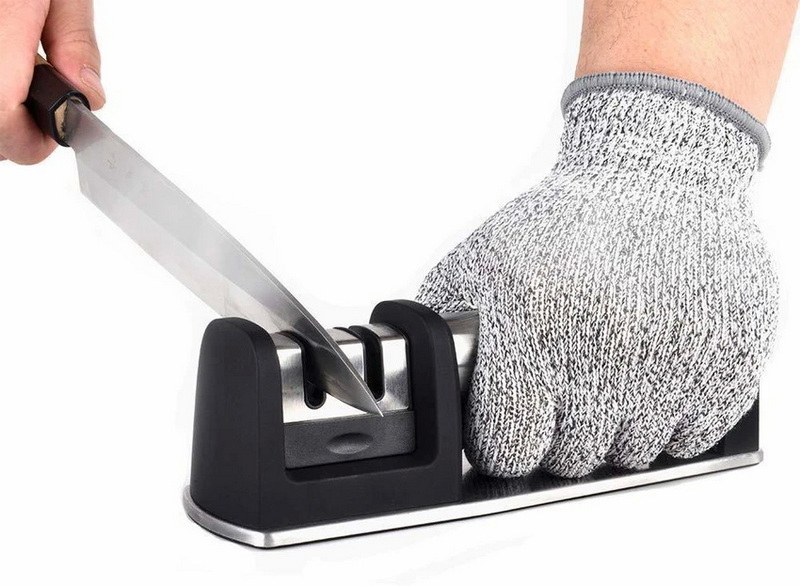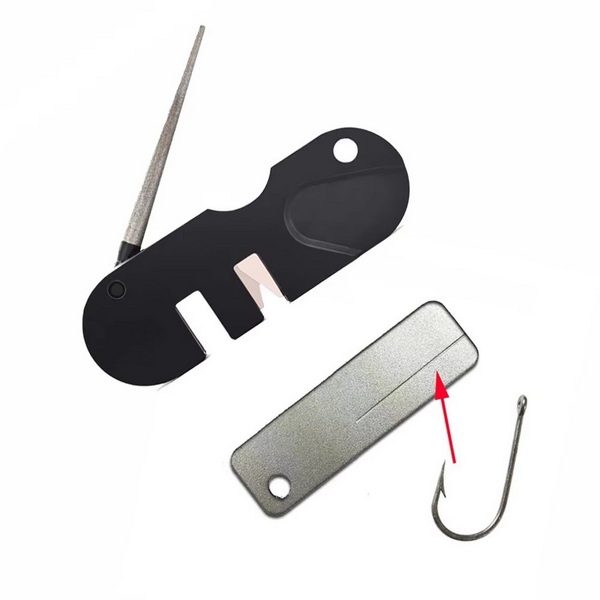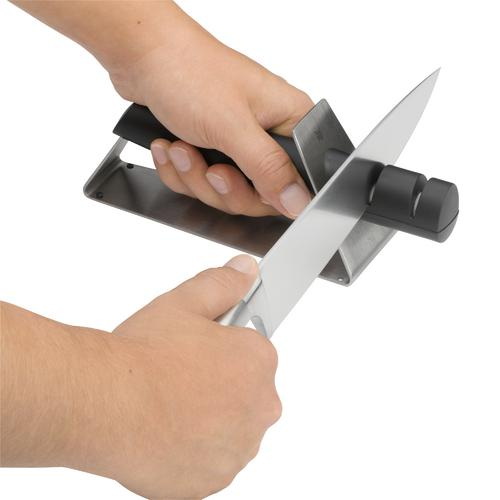Content Menu
● Introduction to Tungsten Carbide Knife Sharpeners
● The Science Behind Tungsten Carbide
● How Tungsten Carbide Knife Sharpeners Work
● Types of Tungsten Carbide Knife Sharpeners
>> Pull-Through Sharpeners
>> Handheld Sharpeners
>> Multi-Stage Sharpeners
● Advantages of Tungsten Carbide Knife Sharpeners
● Limitations and Considerations
● Step-by-Step Guide: How to Use a Tungsten Carbide Knife Sharpener
● Maintenance and Safety Tips
● Historical Background of Tungsten Carbide Knife Sharpeners
● User Scenarios and Practical Applications
>> Kitchen Use
>> Outdoor and Camping
>> Industrial and Workshop Settings
● Maintenance Routines and Troubleshooting Tips
>> Regular Cleaning
>> Inspecting for Wear
>> Troubleshooting Common Issues
● Common Applications
● Comparison: Tungsten Carbide vs. Other Sharpening Methods
● Conclusion
● FAQ: Top 5 Questions About Tungsten Carbide Knife Sharpeners
>> 1. What makes tungsten carbide suitable for knife sharpeners?
>> 2. Can I use a tungsten carbide sharpener on all types of knives?
>> 3. Will using a tungsten carbide sharpener damage my knife?
>> 4. How often should I use a tungsten carbide sharpener?
>> 5. What's the difference between tungsten carbide and ceramic sharpeners?
A tungsten carbide knife sharpener is a specialized tool engineered to restore and maintain the sharpness of knives using the unique properties of tungsten carbide. Known for its extraordinary hardness and durability, tungsten carbide enables these sharpeners to quickly and efficiently hone a wide array of blades. In this comprehensive guide, you will discover the science behind tungsten carbide, the mechanics of these sharpeners, their advantages and limitations, practical applications, maintenance routines, and answers to the most frequently asked questions.

Introduction to Tungsten Carbide Knife Sharpeners
Tungsten carbide knife sharpeners have become a staple in kitchens, workshops, and outdoor gear kits worldwide. Their primary appeal lies in their ability to restore a sharp edge to a dull blade in just a few strokes, making them indispensable for anyone who relies on sharp knives for cooking, work, or recreation.
The Science Behind Tungsten Carbide
Tungsten carbide is a compound formed by combining tungsten and carbon atoms, resulting in a material that is almost as hard as diamond. This exceptional hardness makes tungsten carbide ideal for abrasive tasks such as sharpening steel blades.
- Hardness: Ranks around 9 on the Mohs scale, just below diamond.
- Durability: Highly resistant to wear, ensuring a long lifespan.
- Precision: Its hardness allows for precise edge formation on various blade types.
How Tungsten Carbide Knife Sharpeners Work
Tungsten carbide knife sharpeners typically feature angled or V-shaped inserts. When a blade is drawn through these inserts, the tungsten carbide edges scrape away dull metal, forming a new, sharp edge.
Sharpening Process:
- The user holds the sharpener steady and pulls the knife through the tungsten carbide slot.
- The inserts remove metal from the blade, creating a new, sharper edge.
- Some models use spring-loaded bars that adapt to the blade's angle for more versatile sharpening.
Types of Tungsten Carbide Knife Sharpeners
Pull-Through Sharpeners
- Feature fixed or adjustable tungsten carbide inserts.
- Designed for simple, fast sharpening by pulling the blade through the slot.
Handheld Sharpeners
- Compact and portable.
- Ideal for outdoor activities or quick touch-ups.
Multi-Stage Sharpeners
- Combine tungsten carbide with other abrasives like diamond or ceramic.
- Offer coarse, medium, and fine sharpening stages for comprehensive edge care.
Advantages of Tungsten Carbide Knife Sharpeners
- Speed: Sharpen blades in seconds, perfect for quick maintenance.
- Versatility: Suitable for kitchen, hunting, and utility knives.
- Consistency: Many models maintain a fixed angle for uniform results.
- Durability: Tungsten carbide inserts last longer than most other materials.
- Ease of Use: Minimal skill required, making them accessible to beginners.
Limitations and Considerations
- Aggressiveness: Removes material quickly, which can shorten the lifespan of delicate or premium knives if overused.
- Edge Quality: Produces a sharp, micro-serrated edge that may not be as smooth or durable as one honed with finer abrasives.
- Not Ideal for Serrated Blades: Most are designed for straight edges, though some models can accommodate serrated knives.
- Not for Ceramic Knives: Tungsten carbide can damage brittle ceramic blades.
Step-by-Step Guide: How to Use a Tungsten Carbide Knife Sharpener
1. Place the Sharpener: Set it on a stable, non-slip surface.
2. Grip Securely: Hold the sharpener with one hand and the knife handle with the other.
3. Insert the Blade: Position the blade in the V-shaped tungsten carbide slot.
4. Draw the Blade: Pull the blade through the slot, applying gentle, even pressure.
5. Repeat: Usually, 3–4 passes are enough for a dull blade.
6. Finish: For a finer edge, use a ceramic or fine abrasive stage if available.
7. Clean the Blade: Wipe the blade to remove any metal filings.
Maintenance and Safety Tips
- Clean Regularly: Remove metal shavings from the sharpener after each use.
- Replace Inserts: Some models have removable tungsten carbide bits for extended life.
- Use Light Pressure: Avoid excessive force to prevent unnecessary wear.
- Store Safely: Keep the sharpener dry and out of reach of children.

Historical Background of Tungsten Carbide Knife Sharpeners
Tungsten carbide was first developed in the early 20th century, transforming many industries thanks to its hardness and resistance to wear. Its application in knife sharpeners emerged as a natural evolution, providing a durable and efficient alternative to traditional whetstones and steels. Over time, manufacturers have refined the design and ergonomics of tungsten carbide sharpeners, introducing features such as multi-stage sharpening systems, comfortable grips, and portable models suited for outdoor use. This evolution has made tungsten carbide sharpeners a favorite among chefs, craftsmen, and outdoor enthusiasts.
User Scenarios and Practical Applications
Kitchen Use
In a professional or home kitchen, time and safety are paramount. Tungsten carbide sharpeners allow cooks to quickly restore a sharp edge, ensuring precise cuts and reducing the risk of accidents caused by dull blades. Their ease of use means even novice cooks can maintain their knives without specialized training.
Outdoor and Camping
Outdoor enthusiasts rely on sharp knives for preparing food, building shelters, and other survival tasks. Portable tungsten carbide sharpeners are lightweight and easy to pack, making them essential for camping, hiking, and fishing trips. Their robust construction ensures they perform reliably in rugged conditions.
Industrial and Workshop Settings
In workshops and industrial environments, utility knives and cutting tools see heavy daily use. Tungsten carbide sharpeners provide a quick and durable solution for maintaining these tools, minimizing downtime and ensuring consistent performance throughout demanding tasks.
Maintenance Routines and Troubleshooting Tips
Regular Cleaning
Metal shavings and debris can accumulate in the sharpener's slots, reducing effectiveness. After each use, clean the sharpener with a soft brush or cloth to remove particles and maintain performance.
Inspecting for Wear
Over time, tungsten carbide inserts may wear down or become damaged. Regularly inspect your sharpener and replace inserts as needed to ensure optimal results.
Troubleshooting Common Issues
- Uneven Sharpening: Caused by inconsistent pressure or angle. Practice steady, even strokes and ensure proper alignment.
- Blade Not Getting Sharp: The sharpener may be clogged or worn out. Clean it thoroughly and replace inserts if necessary.
- Damage to Knife Edge: Excessive force or repeated sharpening can damage blades. Use gentle pressure and follow recommended guidelines.
Common Applications
- Kitchen Knives: Chef's knives, paring knives, and utility knives.
- Outdoor Knives: Hunting, fishing, and camping knives.
- Industrial Blades: Utility knives, box cutters, and workshop tools.
Comparison: Tungsten Carbide vs. Other Sharpening Methods
| Feature | Tungsten Carbide Sharpener | Diamond Stone | Ceramic Rod | Whetstone |
| Speed | Very Fast | Fast | Moderate | Slow |
| Ease of Use | Very Easy | Moderate | Easy | Requires Skill |
| Edge Quality | Good (micro-serrated) | Excellent | Very Good | Excellent |
| Material Removal | High | Moderate | Low | Variable |
| Versatility | High | High | Moderate | High |
| Maintenance | Low | Moderate | Low | Moderate |
| Cost | Low to Moderate | Moderate to High | Low to Moderate | Low to High |
Conclusion
Tungsten carbide knife sharpeners are a fast, convenient, and effective solution for maintaining sharp blades in kitchens, workshops, and outdoor settings. Their unique hardness and durability make them ideal for quick touch-ups and regular maintenance, ensuring safety and precision in every cut. However, their aggressive sharpening action means they should be used thoughtfully, especially on high-end or delicate knives. By following best practices for use and maintenance, you can extend the life of both your sharpener and your knives, enjoying consistently sharp edges for years to come.

FAQ: Top 5 Questions About Tungsten Carbide Knife Sharpeners
1. What makes tungsten carbide suitable for knife sharpeners?
Tungsten carbide's extreme hardness allows it to effectively abrade and reshape steel blades, making it ideal for quickly restoring sharp edges.
2. Can I use a tungsten carbide sharpener on all types of knives?
Most straight-edged knives can be sharpened with tungsten carbide sharpeners. Some models are also suitable for serrated knives, but always check the manufacturer's guidelines.
3. Will using a tungsten carbide sharpener damage my knife?
If used excessively or with too much pressure, tungsten carbide sharpeners can remove more material than necessary, potentially shortening the knife's lifespan. Use gentle, controlled strokes to minimize wear.
4. How often should I use a tungsten carbide sharpener?
For regular kitchen use, sharpening once every few weeks is usually sufficient. For heavy use or outdoor knives, sharpen as needed when the blade feels dull.
5. What's the difference between tungsten carbide and ceramic sharpeners?
Tungsten carbide sharpeners are more aggressive and remove material quickly, while ceramic sharpeners are gentler and better suited for fine honing and edge maintenance.
















